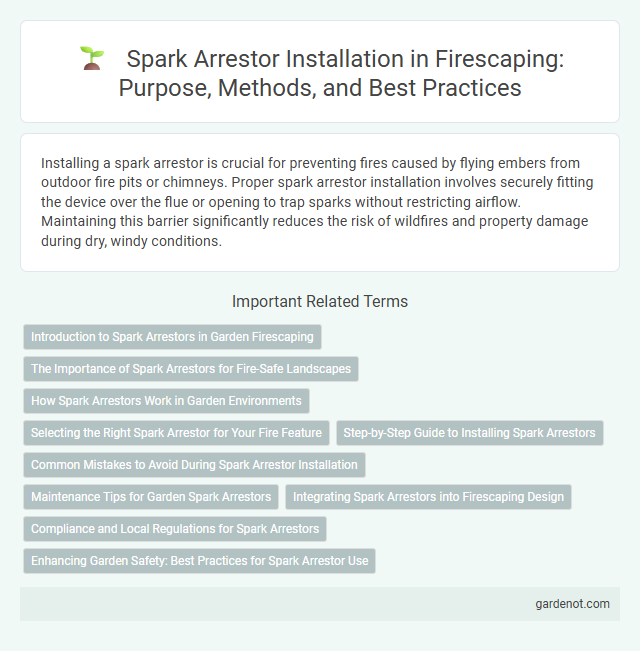Installing a spark arrestor is crucial for preventing fires caused by flying embers from outdoor fire pits or chimneys. Proper spark arrestor installation involves securely fitting the device over the flue or opening to trap sparks without restricting airflow. Maintaining this barrier significantly reduces the risk of wildfires and property damage during dry, windy conditions.
Introduction to Spark Arrestors in Garden Firescaping
Spark arrestors are essential safety devices designed to prevent embers and sparks from escaping chimneys or fire pits, reducing the risk of garden fires during firescaping. Installed at the top of chimneys or over fire features, these metal mesh screens effectively trap flammable particles while allowing smoke to exit safely. Proper installation of spark arrestors enhances fire safety by minimizing the chance of uncontrolled outdoor fires caused by airborne sparks.
The Importance of Spark Arrestors for Fire-Safe Landscapes
Spark arrestors play a crucial role in preventing wildfires by trapping embers and sparks before they can ignite dry vegetation within fire-safe landscapes. Installing spark arrestors on chimneys, stovepipes, and outdoor fire features significantly reduces the risk of accidental fire outbreaks in wildfire-prone areas. Proper maintenance and compliance with local fire safety codes ensure these devices function effectively, protecting properties and surrounding ecosystems from devastating fire damage.
How Spark Arrestors Work in Garden Environments
Spark arrestors function by capturing and cooling embers and sparks generated by outdoor fire pits or wood-burning garden equipment, preventing them from igniting nearby vegetation. These devices use fine mesh screens or baffles to interrupt the passage of hot particles while allowing airflow, effectively reducing the risk of wildfires. Installing spark arrestors in garden environments enhances fire safety, especially in dry or densely planted landscapes where ignition hazards are high.
Selecting the Right Spark Arrestor for Your Fire Feature
Selecting the right spark arrestor for your fire feature depends on the type of fuel used and the size of the opening. Metal mesh spark arrestors with a fine gauge are ideal for wood-burning fire pits, effectively preventing embers from escaping while allowing proper airflow. Ensure the arrestor material is heat-resistant and corrosion-proof to maintain durability and safety around your outdoor fire feature.
Step-by-Step Guide to Installing Spark Arrestors
Begin the spark arrestor installation by selecting a model compatible with your fireplace or chimney system, ensuring it meets local fire safety standards. Carefully measure the chimney or stovepipe diameter to secure a proper fit, then clean the surface to remove soot and debris before attaching the arrestor using screws or clamps provided. Finally, verify the arrestor is firmly installed and unobstructed, maintaining clear airflow while preventing embers from escaping and igniting surrounding combustible materials.
Common Mistakes to Avoid During Spark Arrestor Installation
Incorrect sizing is a common mistake during spark arrestor installation, leading to ineffective combustion gas flow and increased fire risk. Failure to securely fasten the spark arrestor can cause gaps that allow sparks to escape, undermining its protective function. Neglecting regular maintenance and cleaning results in clogging, reducing efficiency and posing potential ignition hazards.
Maintenance Tips for Garden Spark Arrestors
Regular cleaning of garden spark arrestors prevents clogging and ensures optimal airflow, reducing fire risk. Inspect the mesh for damage or rust quarterly and replace any compromised components promptly to maintain efficiency. Applying a rust-resistant coating extends the lifespan and reliability of the spark arrestor in outdoor environments.
Integrating Spark Arrestors into Firescaping Design
Integrating spark arrestors into firescaping design significantly reduces the risk of wildfire ignition by capturing embers from fireplaces, chimneys, and outdoor fire features. Proper placement and maintenance of spark arrestors enhance fire safety by preventing sparks from reaching dry vegetation or combustible materials within defensible spaces. Using durable, corrosion-resistant materials and ensuring compliance with local fire codes optimize the effectiveness of spark arrestors in protecting homes during wildfire seasons.
Compliance and Local Regulations for Spark Arrestors
Spark arrestor installation must adhere to local fire codes and environmental regulations to ensure compliance and prevent wildfires. Many jurisdictions require spark arrestors on outdoor equipment such as fireplaces, chimneys, and wood stoves to meet specific standards set by agencies like the National Fire Protection Association (NFPA) or local fire departments. Verifying compliance with these regulations not only promotes safety but also helps avoid penalties or fines associated with non-compliance.
Enhancing Garden Safety: Best Practices for Spark Arrestor Use
Installing spark arrestors on chimneys and outdoor fire pits significantly reduces the risk of garden fires by capturing flying embers. Regular maintenance, including thorough cleaning and inspection of spark arrestors, ensures optimal performance and safety. Selecting spark arrestors with durable, heat-resistant mesh material maximizes protection while blending seamlessly into garden aesthetics.
Spark arrestor installation Infographic

 gardenot.com
gardenot.com